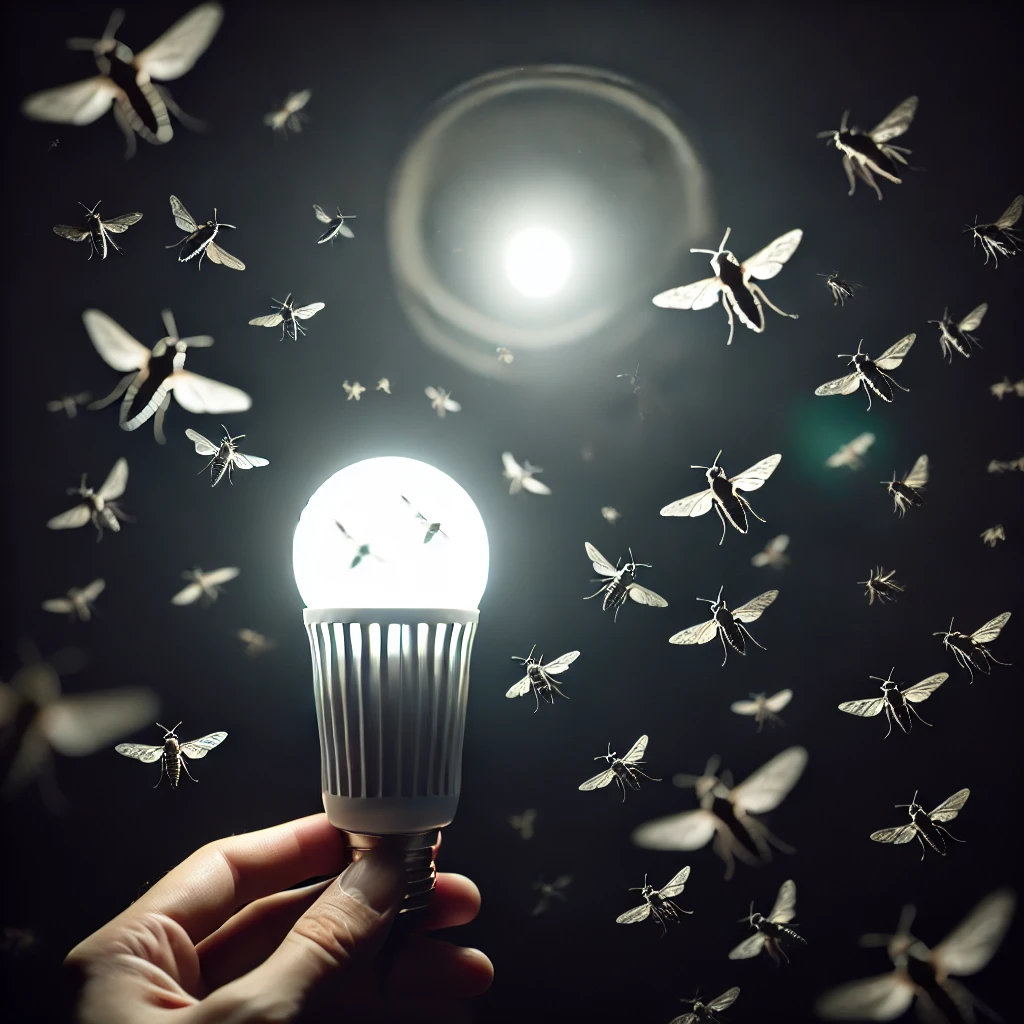Do LED Bulbs Attract Bugs? Understanding Insect Behavior, Light, and Wavelengths
1. Introduction
Many people notice that insects tend to gather around artificial lights at night. But do LED bulbs attract as many bugs as traditional lighting? The answer depends on light wavelength, heat emission, and insect vision sensitivity.
This article explores why bugs fly into lights, which insects respond to LED bulbs, and how to minimize bug attraction using the right lighting solutions.
For more information on choosing outdoor lighting solutions, check out this guide:
👉 Outdoor Lighting Systems for Safety and Security
2. What is the Bug That Comes to Light?
Not all insects are attracted to light, but these common species are:
- Moths – Known for their strong positive phototropism.
- Flies – Many species actively seek artificial light.
- Beetles – Some use light for navigation.
- Mayflies – Swarm around bright light sources, especially near water.
- Crane Flies – Often mistaken for mosquitoes and gather around lights.
Why? Many of these insects use natural light sources like the moon and stars for navigation, and artificial lights disrupt this behavior.

3. Why Do Bugs Fly Into the Light?
Insects fly toward lights due to navigation confusion. Many species use celestial light (moon, stars) for orientation, but artificial light overrides their instincts.
Additionally, light wavelength matters:
- Shorter wavelengths (UV, blue, green) attract more bugs.
- Longer wavelengths (yellow, red) attract fewer bugs.
For a detailed breakdown of how LED technology affects outdoor lighting, read:
👉 Why Are LED Streetlights Replacing Traditional Lights?
4. What is the Name of the Light-Emitting Insect?
Some insects don’t just respond to light—they produce it! These are called bioluminescent insects. Examples include:
- Fireflies (Lightning Bugs) – Emit light to communicate and attract mates.
- Glowworms – Found in forests and caves, using light to lure prey.
- Certain Beetles & Fungi – Some species have evolved natural luminescence.
For more on how light properties impact visibility and efficiency, check out:
👉 The Science Behind CRI: How It Affects Street Light Performance
5. How Do Insects React to Being in the Light?
Different insects react in different ways:
- Flying toward the light – Moths, flies, and beetles exhibit strong positive phototropism.
- Navigational confusion – Bugs may fly in circles around the light.
- Predatory behavior – Spiders and centipedes hunt around bright lights where prey gathers.
- Avoiding light – Cockroaches, ants, and bed bugs prefer darkness and actively avoid bright areas.
6. The Role of Light Wavelength in Bug Attraction
The color of light significantly impacts bug attraction.
| Light Type | Wavelength | Bug Attraction Level |
|---|---|---|
| UV Light (< 400 nm) | Short | Very High |
| Blue Light (400-500 nm) | Short | High |
| Green Light (500-550 nm) | Medium | Moderate |
| Yellow Light (550-600 nm) | Long | Low |
| Red Light (> 600 nm) | Long | Very Low |
Since LED bulbs emit minimal UV light, they attract far fewer bugs than traditional incandescent bulbs.
For a deeper dive into LED wavelengths and efficiency, check out:
👉 Choosing the Right CRI for Street Lighting
7. Heat and Its Impact on Bug Attraction
Bugs aren’t just attracted to light—they are also drawn to heat.
- Incandescent & CFL bulbs produce significant heat, attracting heat-sensitive insects.
- LED bulbs generate minimal heat, making them less attractive to bugs like mosquitoes.
8. Which Bugs Are Attracted to LED Bulbs?
Even though LEDs attract fewer bugs, some species still gather around them:
- Spiders – Not attracted to the light itself but to the insects that gather around it.
- Wasps & Bees – Occasionally drawn to specific light wavelengths.
- Flies & Moths – Still sensitive to bright lights.
- Centipedes – Appear because they feed on other bugs near light sources.
9. Which Bugs Are NOT Attracted to LED Bulbs?
Certain insects are not influenced by LED lights:
- Cockroaches – Prefer dark, damp environments.
- Bed Bugs – Attracted to body heat, not light.
- Ants – More interested in food and moisture than LED bulbs.
10. How to Minimize Bug Attraction to LED Bulbs
To reduce bug attraction, consider these lighting strategies:
- Choose LED bulbs with longer wavelengths (warm white, yellow).
- Install shielded outdoor lighting that directs light downward.
- Use motion-sensor LED lights to reduce unnecessary exposure.
- Maintain a clean outdoor area to remove insect food sources.
A More Direct Solution: Mosquito & Pest Control LED Bulbs
For those seeking a more effective solution to keep insects away from lights, you can now purchase LED bulbs that specifically target pests. These mosquito-killing LED bulbs use UV and blue light to attract insects and then effectively trap or kill them.
Such LED lights are perfect for outdoor spaces, providing both illumination and pest control without the need for harsh chemicals. Check out products like 2025 upgraded mosquito-killing bulbs for efficient, insect-free lighting.
11. How to Prevent Bugs from Entering Light Fixtures
Bugs often find their way into lighting fixtures, which can cause maintenance issues. Solutions include:
- Using fully sealed, enclosed light fixtures to prevent entry.
- Opting for IP-rated outdoor lighting for maximum protection.
- Choosing smooth-surfaced lighting designs that make it harder for bugs to settle.
For a breakdown of outdoor lighting protection, read:
👉 Ensuring Optimal Performance of Outdoor Street Lights in All Weather Conditions
12. Conclusion
So, do LED bulbs attract bugs? The answer is: far less than traditional bulbs, but not entirely bug-free.
- LEDs emit minimal UV light and produce little heat, reducing bug attraction.
- Shorter wavelengths (UV, blue) attract more insects, while longer wavelengths (yellow, red) attract fewer.
- Selecting the right LED bulbs and well-designed fixtures can further minimize insect-related issues.
By understanding insect behavior and light properties, you can make better lighting choices for your outdoor spaces.
For expert guidance on sourcing LED streetlights, check out:
👉 How to Find the Best Streetlight Suppliers in China

